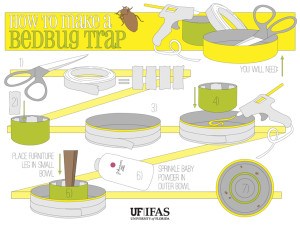

Researchers at the University of Florida’s Institute of Food and Agricultural Sciences created a bedbug trap that can be built with household items. All you need are two disposable plastic containers, masking tape and glue, said Phil Koehler, UF/IFAS urban entomology professor. The traps catch and collect the bugs when they try to travel between people and the places where bedbugs hide, he said.
 The traps rely on the bugs’ poor ability to climb on smooth surfaces, Koehler said. The traps have rough areas to let bedbugs enter easily, and a smooth-surfaced moat that keeps them from escaping.
The traps rely on the bugs’ poor ability to climb on smooth surfaces, Koehler said. The traps have rough areas to let bedbugs enter easily, and a smooth-surfaced moat that keeps them from escaping.
An April 2013 survey by the National Pest Management Association showed that nearly every pest management professional, 99.6 percent, had encountered a bedbug infestation during the prior 12 months. Nearly half, 49 percent, said infestations occur mostly in the summer. Because more people tend to travel and relocate during the summer, it’s possible more of them unknowingly bring bugs home or discover them soon after moving, according to the pest management group.
Entomologists say bedbugs are becoming more resistant to pesticides, exacerbating what is also an expensive problem.
Bedbug treatments can run $3,000 for a single-family home or $1,200 for a low-income apartment.
Koehler and his colleagues created their trap from about $1 worth of household items. The number of traps needed for any given dwelling depends on the number of places people sleep. Researchers estimate one would need about 50 traps for a typical three-bedroom home, enough to place one under each leg of furniture, including chairs, sofas and beds.
The bedbug trap is the brainchild of Koehler; Benjamin Hottel, an entomology doctoral student; Rebecca Baldwin, assistant urban entomology professor; and Roberto Pereira, an associate research scientist in the UF entomology and nematology department.